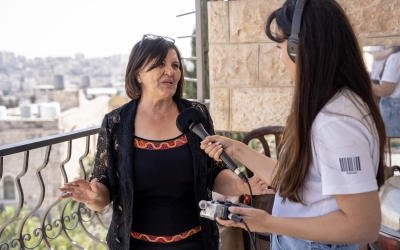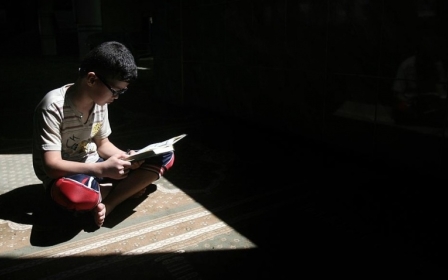Israel's seizure of Sebastia symbolises its theft of Palestine's cultural sites

"Israel seizes cultural site in West Bank." So read a recent headline in the Financial Times, going on to describe how the Israeli military had seized a plot of Palestinian land at the summit of Tel Sebastia, a site rich with archaeological significance and tourism potential.
In 2012, Palestine submitted an application for Sebastia to gain Unesco World Heritage status on the basis of its ancient remains from the Iron Age, Persian, Hellenistic, Roman, Byzantine and Islamic periods.
Israel’s heritage ministry, on the other hand, confirmed plans to erect a "gigantic" Israeli flagpole there, for unspecified "military needs", according to a document seen by the Financial Times.
"The seizure this month," the FT writes, "was one of several moves by Prime Minister Benjamin Netanyahu’s far-right government to expand control over cultural heritage sites in the West Bank, alongside numerous moves to expand Jewish settlements and entrench Israel’s presence in the occupied territory."
Cultural heritage can be a powerful tool. It is, of course, standard practice for countries to use it to enhance their own national identity and image.
New MEE newsletter: Jerusalem Dispatch
Sign up to get the latest insights and analysis on Israel-Palestine, alongside Turkey Unpacked and other MEE newsletters
But in the case of Israel, the land is not owned by them, but illegally occupied, according to the 19 July 2024 opinion of the International Court of Justice in The Hague. The land grab took place just days before, on 10 July.
Throughout my lifetime, I have visited virtually every cultural heritage site in the occupied West Bank, independently and unescorted, with varying degrees of difficulty, thanks to the obstacles the Israeli state routinely puts in the way.
None was more difficult than my visit to Sebastia, in spring 2016. Citing "security concerns", Israel’s objective appears to be preventing tourism revenue from reaching the Palestinians.
Dangerous and forbidden
There are no public railways, metros, trams or public buses in the West Bank (or Gaza), as there are in Israel, and car rental is far from straightforward. Finding a hire car insurable in both Israel and the West Bank is the first challenge. From Tel Aviv airport, it is impossible.
I eventually found a small company in East Jerusalem able to offer dual insurance. Maps are another problem. Israeli tourist maps show the West Bank as a near blank, with barely any roads. GPS is limited and apps such as Waze, originally developed in Israel, simply stop when you cross from Israel into the West Bank, informing you it is dangerous and forbidden to Israeli citizens. Google Maps is equally misleading.
Follow Middle East Eye's live coverage of the Israel-Palestine war
My first attempt to cross the Israeli West Bank barrier (known by Palestinians as "the wall of apartheid") was at the Tulkarm crossing point.
I was denied access by Israeli soldiers, without explanation, and left with no alternative but to drive 50km south to a point where there was no checkpoint on entry, a detour that took nearly two hours.
Finally, just as I was within a few kilometres of my destination, an Israeli military jeep appeared in my rearview mirror, chasing me and forcing my car over to the roadside. Two young armed soldiers got out, and aggressively told me to turn back, as it was "too dangerous" to visit Sebastia.
They made me turn the car around, even driving behind me for some five kilometres to ensure that I obeyed.
Once their jeep had dropped back, I stopped the car and phoned the Palestinian owner of the guesthouse in Sebastia where I had booked to stay a few nights. He assured me there was no danger at all, took details of where I was and within 15 minutes came to meet me, in a local taxi, which then led the way to Sebastia via a back route, away from Israeli checkpoints.
Once at Sebastia, my family and I enjoyed several peaceful days’ walking in the hills, without a guide. We felt safe at all times, even leaving the rental car and hotel rooms unlocked. Our Palestinian host was warmth and hospitality personified.
The cultural site itself was tranquil, too, except when busloads of Israeli tourists arrived, complete with military escort, no doubt having been informed that it was "too dangerous" to visit any other way.
There were no fences or entry tickets.
'Incrementalism'
Three millennia ago, Sebastia (known in Hebrew as Samaria) was the capital of the ancient Israelite kingdom, a biblical prominence that makes it the target of Israeli religious nationalists eager to settle and develop the site.
Local problems first began when the illegal Israeli settlement of Shavei Shomron (Returnees of Samaria) was founded in 1977, a year after newly elected Prime Minister Menachem Begin staged a sit-in with the Zionist group Gush Emumim (Bloc of the Faithful) at the abandoned Sebastia railway station, on a branch of the Hejaz railway to nearby Nablus.
Claiming their right based on its proximity to Samaria, the Israeli demonstrators demanded that the area be settled by Jews. In 2013, the settlers at Shavei Shomron began pumping their sewage into nearby Palestinian fields, killing crops. The international community looked away.
Israel has occupied the territory since capturing it in the 1967 war, along with the Gaza Strip and East Jerusalem. Under the 1993 Oslo Accords, the archaeological ruins themselves are designated Area C (full Israeli civil and security control, around 63 percent of the West Bank), the car park is Area B (Palestinian civil control and joint Israeli-Palestinian security control, 22 percent of the West Bank) and the Palestinian town of Sebastia is designated Area A (full civil and security control by the Palestinian Authority, 18 percent of the West Bank).
Last year, Netanyahu’s government earmarked $8.7m to develop the site for tourism and begin charging entry fees, a move aimed at cutting off the Palestinian residents of Sebastia from their heritage and depriving them of their livelihood.
The Israelis have been carefully laying the groundwork for a takeover of the Sebastia site by turning it into one of their many national parks
As masters of the well-tested method of "incrementalism", the Israelis have been carefully laying the groundwork for a takeover of the site by turning it into one of their many national parks, the same technique they have used all over the illegally annexed Golan Heights to claim areas such as ancient Banias, City of Pan, once a Syrian tourist site.
Banias sits at the foot of Mt Hermon, beside its cliffside spring, which forms the Banias Stream, a key tributary of the Jordan River. It then flows into the Sea of Galilee, Israel’s largest reservoir.
Steeped in biblical associations, it was in Banias that Jesus told Peter he would be the Rock of the Church and be given the keys to the kingdom of Heaven (Matthew XVI, 13-16). Above the spring grotto, a Christian sanctuary to St George, whom Muslims called al-Khidr (the green one), was built and later converted to a mosque, maintained by the local Syrian Druze of the Golan.
On the penultimate day of the Six-Day War in June 1967, Israeli tanks breached a UN ceasefire that had been accepted by Syria, storming into Banias. The Arab villagers fled to the Syrian Druze village of Majdal Shams higher up the mountain, waiting to return.
Israeli bulldozers raised their Banias homes to the ground a few months later. Only the mosque, the church and the shrines were spared, along with the rocktop Ottoman house of the sheikh.
Israeli general, Moshe Dayan, unilaterally seized the Golan Heights from Syria. Within days, Israeli volunteers began building on the banks of the Banias Stream, creating Kibbutz Snir, the first Israeli settlement on the Golan. In 1981, Israel annexed the Golan, a move illegal under international law, but no foreign power intervened.
Erased
Today, the Golan is covered in scores of settlements. Dozens of hotels offer settler-made "Chateau Golan" wine and the region serves as a popular weekend getaway for Israeli city elites, especially in summer.
Even in winter, the Israeli-built ski resort on Mt Hermon draws daytrippers. All Israeli maps show it as part of Israel.
Banias, emptied of its Arab residents, has now been incorporated into one of Israel’s many "nature reserves" on the Golan, laid out with walking trails for visitors.
At the time of my 2016 visit, the leaflet handed out with the entry ticket read "Banias is a perfect place to understand the pagan world of the Land of Israel and Phoenicia".
The souvenir shop was selling T-shirts emblazoned with "Israeli Air Force" and "Mossad". The Israeli site map shows what was once a basilica as a synagogue and the Ottoman sheikh's house as "Corner Tower".
Any trace of previous Syrian ownership has been erased.
Before the Israeli occupation of 1967, Sebastia had been the number one tourist site in the region.
It remains to be seen whether the recent ICJ opinion, declaring Israel’s occupation to be illegal, will spare Sebastia the same fate as Banias, and whether Unesco will approve its World Heritage status in time to protect it from an Israeli takeover.
The views expressed in this article belong to the author and do not necessarily reflect the editorial policy of Middle East Eye.
Middle East Eye delivers independent and unrivalled coverage and analysis of the Middle East, North Africa and beyond. To learn more about republishing this content and the associated fees, please fill out this form. More about MEE can be found here.






